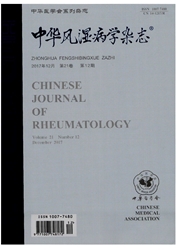

 中文摘要:
中文摘要:
目的:检测类风湿关节炎(rheumatoid arthritis,RA)患者外周血中滤泡辅助性T(T follicular helper,Tfh)淋巴细胞亚型以及效应型滤泡辅助性T(T follicular helper effector memory,Tfhem)细胞的表达,并探讨二者作为活动性RA患者血液标志物的价值。方法:流式细胞术分别检测41例RA患者和32例健康受试者的外周血中Tfh(CD3~+CD4^+CXCR5^+CD45RA-)细胞亚型Tfh1(CXCR3~+CCR6-Tfh)、Tfh2(CXCR3-CCR6-Tfh)、Tfh17(CXCR3-CCR6~+Tfh)和Tfhem(CD4^+CXCR5^+CCR7lowPD-1high)的水平。收集入组RA患者的临床资料及实验室指标,分析上述细胞亚型表达水平与RA疾病活动和实验室指标的相关性,酶联免疫吸附法(enzyme-linked immunosorbent,ELISA)检测相关血清细胞因子。结果:RA患者外周血中Tfhem细胞的表达率明显高于正常对照组(12.8%±5.7%vs.8.7%±2.0%,P=0.001)。Tfhem细胞表达水平与RA患者疾病活动指数(disease activity score in 28joints,DAS28)及红细胞沉降率(erythrocyte sedimentation rate,ESR)存在显著相关性(r(DAS28)=0.205,r(ESR)=0.141,P〈0.05),与抗角蛋白抗体(anti-keratin antibody,AKA)、抗核周因子(anti-perinuclear factor,APF)及Ig M型类风湿因子(immunoglobulin M-rheumatoid factors,Ig M-RF)、Ig A、Ig M及Ig G等临床指标则无明显相关性。Tfh2表达水平在RA组显著高于正常对照组(3.002%±0.408%vs.1.730%±0.160%,P=0.013)。Tfh2-high组RA患者的Ig A[(3.045±0.261)g/L vs.(3.963±0.815)g/L,P=0.172]、Ig G[(13.800±0.862)g/L vs.(16.980±0.224)g/L,P=0.161]和Ig M[(1.135±0.083)g/L vs.(1.731±0.380)g/L,P=0.140]高于Tfh2-low组,但差异尚无统计学意义(P〉0.05)。与Tfh低表达组相比,Tfh2高表达组血清中IL-4[(2.322±0.214)ng/L vs.(3.994±0.751)ng/L,P=0.056]和IL-10[(1.898±0.105)ng/L vs.(3.125±0.880)ng/L,P=0.140]升高,差异无统计学意义(P〉0.05)。结论:Tfhem细胞的表达与RA患者
 英文摘要:
英文摘要:
Objective: To detect the expressions of T follicular helper( Tfh) subsets and T follicular helper effect memory( Tfhem) cells in circulation of patients with rheumatoid arthritis( RA),as well as to examine their roles in providing biomarkers for active RA. Methods: This study enrolled 41 patients with RA,who were navely-treated or had no application of hormone and disease-modifying anti-rheumatic drugs in recent 3 months,as well as 32 healthy controls. The percentages of Tfhem( CD4^+CXCR5^+CCR7lowPD1high) cells,Tfh( CD3~+CD4^+CXCR5^+CD45RA-) subsets,Tfh1( CXCR3~+CCR6-Tfh),Tfh2( CXCR3-CCR6-Tfh),and Tfh17( CXCR3-CCR6~+Tfh),were determined by flow cytometry of peripheral blood from the patients with RA and health controls. Serum levels of cytokines were detected by enzyme-linked immunosorbent( ELISA). The correlations of Tfhem / Tfh subsets with clinical indicatorswere analyzed. Results: The mean age of the patients was( 56. 1 ± 14. 0) years( range: 20-82 years),the mean disease duration was( 8. 2 ± 8. 1) years. There was no significant difference between the RA patients and the health controls with age and gender. As compared with the health control,the percentage of Tfhem was significantly increased in the peripheral blood of the RA patients( 12. 8% ± 5. 7% vs.8. 7% ± 2. 0%,P = 0. 001). Moreover,the increased Tfhem was correlated with the higher disease activity score in 28 joints( DAS28) and erythrocyte sedimentation rate( ESR),but not with other clinical indicators,such as C-reactive protein( CRP),anti-cyclic citrullinated peptide( CCP) antibodies,and rheumatoid factors( RF). In addition,the percentage of Tfh2 subset,but not Tfh1 or Tfh17,was significantly increased in the RA patients( 3. 002% ± 0. 408% vs. 1. 730% ± 0. 160%,P = 0. 013). As compared with Tfh2-low group,serum levels of Ig( immunoglobulin) A [( 3. 045 ± 0. 261) g / L vs.( 3. 963 ± 0. 815) g /L,P = 0. 172],Ig G [( 13. 800 ± 0.
 同期刊论文项目
同期刊论文项目
 同项目期刊论文
同项目期刊论文
 期刊信息
期刊信息
